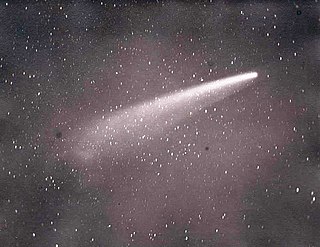Related Research Articles

The Solar and Heliospheric Observatory (SOHO) is a European Space Agency (ESA) spacecraft built by a European industrial consortium led by Matra Marconi Space that was launched on a Lockheed Martin Atlas IIAS launch vehicle on 2 December 1995, to study the Sun. It has also discovered over 5,000 comets. It began normal operations in May 1996. It is a joint project between the European Space Agency (ESA) and NASA. SOHO was part of the International Solar Terrestrial Physics Program (ISTP). Originally planned as a two-year mission, SOHO continues to operate after over 25 years in space; the mission has been extended until the end of 2025, subject to review and confirmation by ESA's Science Programme Committee.

A sungrazing comet is a comet that passes extremely close to the Sun at perihelion – sometimes within a few thousand kilometres of the Sun's surface. Although small sungrazers can completely evaporate during such a close approach to the Sun, larger sungrazers can survive many perihelion passages. However, the strong evaporation and tidal forces they experience often lead to their fragmentation.

The Great Comet of 1843, formally designated C/1843 D1 and 1843 I, was a long-period comet which became very bright in March 1843. It was discovered on February 5, 1843, and rapidly brightened to become a great comet. It was a member of the Kreutz Sungrazers, a family of comets resulting from the breakup of a parent comet into multiple fragments in about 1106. These comets pass extremely close to the surface of the Sun—within a few solar radii—and often become very bright as a result.

The Great Comet of 1882 formally designated C/1882 R1, 1882 II, and 1882b, was a comet which became very bright in September 1882. It was a member of the Kreutz Sungrazers, a family of comets which pass within 1 R☉ of the Sun's photosphere at perihelion. The comet was bright enough to be visible next to the Sun in the daytime sky at its perihelion. The comet made its closest approach to Earth on 16 September 1882 at 0.99 AU and then came to perihelion the next day on 17 September.
The Kreutz sungrazers are a family of sungrazing comets, characterized by orbits taking them extremely close to the Sun at perihelion. At the far extreme of their orbits, aphelion, Kreutz sungrazers can be a hundred times farther from the Sun than the Earth is, while their distance of closest approach can be less than twice the Sun's radius. They are believed to be fragments of one large comet that broke up several centuries ago and are named for German astronomer Heinrich Kreutz, who first demonstrated that they were related. These sungrazers make their way from the distant outer Solar System to the inner Solar System, to their perihelion point near the Sun, and then leave the inner Solar System in their return trip to their aphelion.

Comet White–Ortiz–Bolelli was a bright comet which appeared in 1970. It was a member of the Kreutz Sungrazers, a family of comets which resulted from the break-up of a large parent comet several centuries ago. It was already easily visible to the naked eye when first discovered, and reached a maximum apparent magnitude of +1.

Comet Pereyra was a bright comet which appeared in 1963. It was a member of the Kreutz Sungrazers, a group of comets which pass extremely close to the Sun.

C/1680 V1, also called the Great Comet of 1680, Kirch's Comet, and Newton's Comet, was the first comet discovered by telescope. It was discovered by Gottfried Kirch and was one of the brightest comets of the seventeenth century.

Comet McNaught, also known as the Great Comet of 2007 and given the designation C/2006 P1, is a non-periodic comet discovered on 7 August 2006 by British-Australian astronomer Robert H. McNaught using the Uppsala Southern Schmidt Telescope. It was the brightest comet in over 40 years, and was easily visible to the naked eye for observers in the Southern Hemisphere in January and February 2007.

Comet 96P/Machholz or 96P/Machholz 1 is a short-period sungrazing comet discovered on May 12, 1986, by amateur astronomer Donald Machholz on Loma Prieta peak, in central California using 130 millimetres (5.1 in) binoculars. On June 6, 1986, 96P/Machholz passed 0.404 AU from the Earth. 96P/Machholz last came to perihelion on January 31, 2023. The comet has an estimated diameter of around 6.4 km (4.0 mi).

Terry Lovejoy is an information technologist from Thornlands, Queensland, Australia, most widely known as an amateur astronomer. He has discovered six comets, including C/2011 W3 (Lovejoy), the first Kreutz Sungrazing comet discovered by ground-based observation in over 40 years. He is also known for popularizing procedures for modifying consumer-grade digital cameras so that they can be used for digital camera astrophotography.
Comet 322P/SOHO, also designated P/1999 R1, P/2003 R5, P/2007 R5, and P/2011 R4, is the first periodic comet to be discovered using the automated telescopes of the SOHO spacecraft, and second to be given a numbered designation, after 321P/SOHO. JPL Horizons next predicts 322P to come to perihelion on 21 August 2023 at around apparent magnitude 6 and only 3 degrees from the Sun. At perihelion it is six times closer to the Sun than the planet Mercury is at perihelion.

The Great Southern Comet of 1887, or C/1887 B1 using its International Astronomical Union (IAU) designation, was a bright comet seen from the Southern Hemisphere during January 1887. Later calculations indicated it to be part of the Kreutz Sungrazing group. It came to perihelion on 11 January 1877 at a distance of 0.00483 AU (723 thousand km) with a velocity of 606.1 km/s. Since the Sun has a radius of 696000 km, the comet passed about 27000 km from the surface of the Sun.

C/2011 L4 (PanSTARRS), also known as Comet PANSTARRS, is a non-periodic comet discovered in June 2011 that became visible to the naked eye when it was near perihelion in March 2013. It was discovered using the Pan-STARRS telescope located near the summit of Haleakalā, on the island of Maui in Hawaii. Comet C/2011 L4 probably took millions of years to come from the Oort cloud. After leaving the planetary region of the Solar System, the post-perihelion orbital period is estimated to be roughly 107000 years. Dust and gas production suggests the comet nucleus is roughly 1 kilometer (0.62 mi) in diameter, while based on the absolute nuclear magnitude and a geometric albedo of 0.04 the diameter of the nucleus is over 2.4 kilometers (1.5 mi). A method based on coma magnitude decay function estimated the effective radius at 2.317 ± 0.190 km.

Comet Lovejoy, formally designated C/2011 W3 (Lovejoy), is a long-period comet and Kreutz sungrazer. It was discovered in November 2011 by Australian amateur astronomer Terry Lovejoy. The comet's perihelion took it through the Sun's corona on 16 December 2011, after which it emerged intact, though greatly impacted by the event.

Comet ISON, formally known as C/2012 S1, was a sungrazing comet from the Oort cloud which was discovered on 21 September 2012 by Vitaly Nevsky and Artyom Novichonok.
C/1999 J6 (SOHO) is a small comet, notable for being among those that made a close approach to the Earth. It was first observed by the space-based Solar and Heliospheric Observatory (SOHO) on 10 May 1995. It is next expected to come to perihelion in June 2026 at 0.044 AU (6.6 million km).
The Great Comet of 372–371 BC was a comet that is thought to possibly be the source of the Kreutz sungrazer family.
References
- 1 2 3 "The 2012 "SWAN-grazer": Comet Lovejoy version 2.0?". Archived from the original on 2018-12-23. Retrieved 2013-03-16.
- ↑ Musgrave, Ian. "Comet Swan Enters LASCO C2, and STEREO COR1 and 2".
- ↑ "Bright comet makes SWAN dive into sun today".
- ↑ "JPL Small-Body Database: C/2012 E2 (SWAN)". Jet Propulsion Laboratory . Retrieved 2023-09-02.

